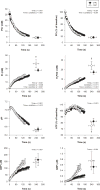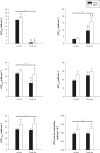Bioenergetics and ATP Synthesis during Exercise: Role of Group III/IV Muscle Afferents
- PMID: 28767527
- PMCID: PMC5688004
- DOI: 10.1249/MSS.0000000000001391
Bioenergetics and ATP Synthesis during Exercise: Role of Group III/IV Muscle Afferents
Abstract
Purpose: The purpose of this study was to investigate the role of the group III/IV muscle afferents in the bioenergetics of exercising skeletal muscle beyond constraining the magnitude of metabolic perturbation.
Methods: Eight healthy men performed intermittent isometric knee-extensor exercise to task failure at ~58% maximal voluntary contraction under control conditions (CTRL) and with lumbar intrathecal fentanyl to attenuate group III/IV leg muscle afferents (FENT). Intramuscular concentrations of phosphocreatine (PCr), inorganic phosphate (Pi), diprotonated phosphate (H2PO4), adenosine triphosphate (ATP), and pH were determined using phosphorous magnetic resonance spectroscopy (P-MRS).
Results: The magnitude of metabolic perturbation was significantly greater in FENT compared with CTRL for [Pi] (37.8 ± 16.8 vs 28.6 ± 8.6 mM), [H2PO4] (24.3 ± 12.2 vs 17.9 ± 7.1 mM), and [ATP] (75.8% ± 17.5% vs 81.9% ± 15.8% of baseline), whereas there was no significant difference in [PCr] (4.5 ± 2.4 vs 4.4 ± 2.3 mM) or pH (6.51 ± 0.10 vs 6.54 ± 0.14). The rate of perturbation in [PCr], [Pi], [H2PO4], and pH was significantly faster in FENT compared with CTRL. Oxidative ATP synthesis was not significantly different between conditions. However, anaerobic ATP synthesis, through augmented creatine kinase and glycolysis reactions, was significantly greater in FENT than in CTRL, resulting in a significantly greater ATP cost of contraction (0.049 ± 0.016 vs 0.038 ± 0.010 mM·min·N).
Conclusion: Group III/IV muscle afferents not only constrain the magnitude of perturbation in intramuscular Pi, H2PO4, and ATP during small muscle mass exercise but also seem to play a role in maintaining efficient skeletal muscle contractile function in men.
Conflict of interest statement
The authors declare no conflict of interest, financial or otherwise.
Figures



Comment in
-
Effort, Discomfort, Group III/IV Afferents, Bioenergetics, and Motor Unit Recruitment.Med Sci Sports Exerc. 2018 Aug;50(8):1718. doi: 10.1249/MSS.0000000000001605. Med Sci Sports Exerc. 2018. PMID: 30005057 No abstract available.
-
Response.Med Sci Sports Exerc. 2018 Aug;50(8):1719. doi: 10.1249/MSS.0000000000001606. Med Sci Sports Exerc. 2018. PMID: 30005058 Free PMC article. No abstract available.
References
-
- Bawa P, Murnaghan C. Motor unit rotation in a variety of human muscles. J Neurophysiol. 2009;102:2265–72. - PubMed
MeSH terms
Substances
Grants and funding
LinkOut - more resources
Full Text Sources
Other Literature Sources
Medical
Research Materials
Miscellaneous

